Old and New Motorcycle Riders Weigh In on Can-Am Spyder
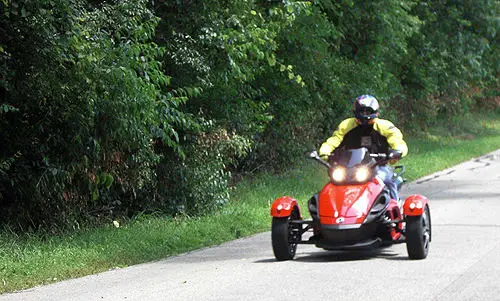
While Cars.com reviews lots of, well, cars, we also have a few experts of the two-wheeled variety. We asked two riders — one with a considerable amount of experience and one who’s just starting out — to test the new Can-Am Spyder model. We wanted to know if the three-wheeler vehicle would impress them and how it compares with riding a traditional bike.

- Rider: Brian Neale
- Age: 41
- Motorcycle experience: 20+ years, 50,000+ miles
- Current ride: Kawasaki ZRX-1100
KickingTires: The Can-Am Spyder requires a motorcycle license for operation in most states. Could a person with no prior motorcycle experience safely ride the Spyder? As an experienced rider, what were your impressions?
Short answer: Sure, a new rider could handle the Can-Am Spyder, but I wouldn’t recommend it to just anyone. And I sure wouldn’t bet my life on it by riding as a passenger with someone who wasn’t already an accomplished biker.
Long answer: Despite my reluctance to climb aboard the Spyder with a newbie, I actually think California and Delaware are on the right side of logic by not mandating a motorcycle license to operate one on public roads.
The physical skills and balance required to earn a motorcycle certification are almost meaningless on the Spyder, so why require a rider to prove basic operational competence on two wheels before climbing aboard this three-wheeler?
It’s not like getting a motorcycle license automatically makes you a safe rider, any more than getting a driver’s license on your 16th birthday makes you a safe driver.
The first thing you have to understand about BRP’s Can-Am Spyder is that it isn’t a motorcycle with three wheels. Sure, it has handle-bar steering, motorcycle-like controls, a single rear wheel and a V-twin engine that’s a close sibling to one used in race bikes. But adding two wheels and a racecar style suspension up front doesn’t make the backward trike ride or handle like a motorcycle — at all.
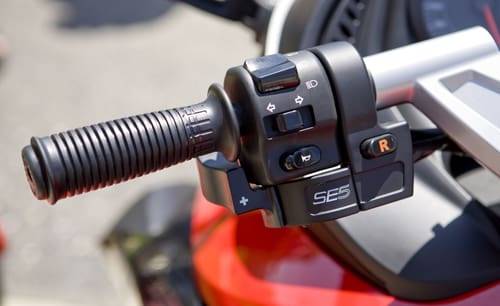
The Spyder is a high-performance sport “something-else” vehicle, neither car nor bike nor ATV. If you can drive any of those things, after a few minutes of orientation to the Spyder’s controls you (or your mom) will be ready for your first lap around an empty parking lot — especially if you spring for the optional semi-automatic transmission ($1,500), which removes the complication of a hand clutch and foot shifter in favor of a marvelous, near-idiot-proof electronic paddle shifter. All you have to worry about are the upshifts. If you’re late with a downshift, the onboard computer takes care of it for you, so you never find yourself wanting for power.
After a few laps around the empty parking lot, you’ll have the hang of starting, shifting, turning and stopping, and you’ll feel like taking on real streets. (Your mom will probably want to call it a day after the parking lot.)
At cruising speed under a smooth throttle, the Spyder is well-behaved and offers an instantly fun experience that feels almost like driving a really powerful go-kart. It’s very predictable, going exactly where you point it, and stops easily when and where you want it to.
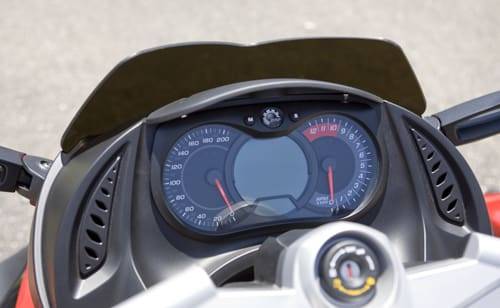
At, shall we say, brisker speeds, the Spyder provides an exhilarating experience that demands you hang on tight and actually ride the thing, much as you would a performance ATV. You have to push the handlebars a lot harder to initiate a turn, and for sharp curves it handles best if you lean your body inside; otherwise, it wants to toss you right off the other side of the trike. If you want to ride it hard, you’re going to get a workout.
And yet it still feels remarkably well-behaved, coaxing you to push it harder and inspiring confidence with every corner you carve. The advanced stability and traction control systems work unobtrusively to keep all three wheels on the ground and keep you from getting in over your head, at least as far as controlling the machine is concerned.
So why wouldn’t I necessarily recommend it for a non-rider?
The Spyder isn’t a toy, or anything close to it. This a highly tuned, high-performance machine that makes you feel confident very quickly. That can be a recipe for disaster — think 16-year-old boy in a new Corvette.
All that fast-found confidence might tempt one to not bother slowing down for a 35-mph curve, and that could spell trouble. While the Spyder’s linked front-and-rear ABS system, two front wheels and long wheelbase let you brake hard and still change direction should you meet an obstacle around that curve, you’ll still need reaction speed, instincts and practice to decide what to do and execute well.
A good motorcycle rider develops these skills over time, and smart ones do it long before they start exploring the upper limits of their machine’s performance. On top of that, the Spyder is almost three times wider than a motorcycle, which automatically means your escape route and margin for error is more like a car’s.
Given its hefty price tag, I think the Spyder’s greatest appeal will be with adrenaline junkies who already have a bike or two in the garage, a PWC or ATV in the shed, and a fat bank account. For most riders, the primary attraction will be the novelty of the thing, the thrill of riding it hard and its ability to do effortless, straight-line burnouts all the way down the block.
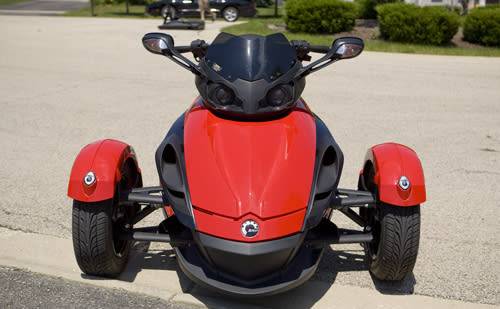
- Rider: Eric Rossi
- Age: 27
- Motorcycle experience: Less than two years
- Current ride: Kawasaki Ninja 500R
KickingTires: As a novice motorcycle rider, what were your impressions of the Can-Am Spyder?
Rossi: As a new rider, my main concern was the learning curve — not just how to operate the Spyder, but what to do if and when I were presented with an emergency situation. I spent so much time learning to ride on two wheels, I thought it would take as long to get fully comfortable on three.
Turns out, the learning curve on the Spyder is very shallow, especially with the sequential five-speed automatic. The controls are a mix of the easiness of an automobile and the layout of a motorcycle. Like Brian said, after about 10 minutes on the Spyder you feel ready to take on the open road. That took me hours to feel on two wheels.
The stability added by the two front wheels not only changed the handling properties, it also kept the bike upright at stop lights and took away the need to lean the machine into turns; like Brian said, you do need to shift your body weight into turns to keep yourself on the machine, but that’s an easier task than leaning a several-hundred-pound piece of steel on two wheels into a turn.
The third wheel also makes riding on rough roads easier. Pothole in the road? No need for an emergency swerve when you have two wheels up front and an independent suspension.
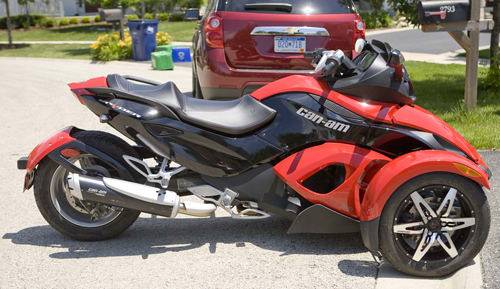
After my second day with the Spyder, I found myself caught in the middle of a quick but bad summer thunderstorm. With very little “rain riding” under my belt, this was not a situation I was comfortable with; had I been on my bike, I probably would have pulled over, but not with the Spyder. The 700-pound trike was firmly planted, and the antilock brakes and stability control allowed me to stop with ease and accelerate with very limited slipping. The technology and stability made me feel completely in control of the machine, which allowed me to focus my attention on the chaos around me.
When the roads were dry and open, the 106-hp Spyder did not disappoint. A hard twist of the throttle let out a deep, loud exhaust note, spun the rear tire and launched the Spyder off the line. One quick tap of the transmission into 2nd and — BAM! You pass 60 mph and it’s time for 3rd!
If you’ve ever ridden a snowmobile, ATV or Jet Ski, the Spyder requires the same type of control, but it’s also very precise and predictable. The only thing that was difficult about the Spyder was remembering I was still on a “motorcycle.” You still need to scan the road for potential hazards, but having the ability to hard brake was great — especially given a lot of people either stared at me, wondering what I was driving as they drifted ever closer, or just didn’t see me at all.
The price is pretty significant, starting at $16,199 for a manual Spyder. That’s on the very high end for a motorcycle, but if you look at the prices of most recreational toys lately, the Can-Am’s price is right in that ballpark.
Featured stories




